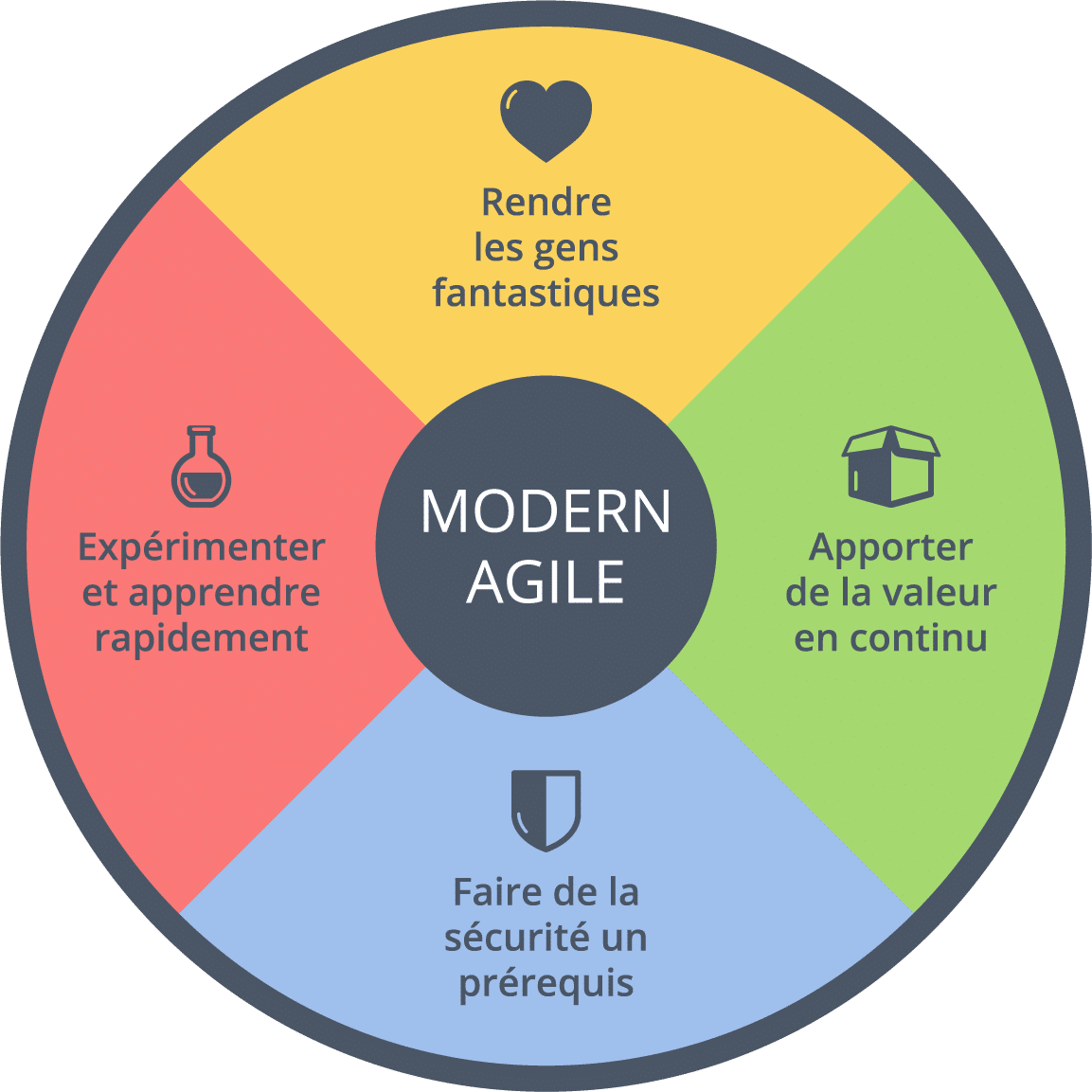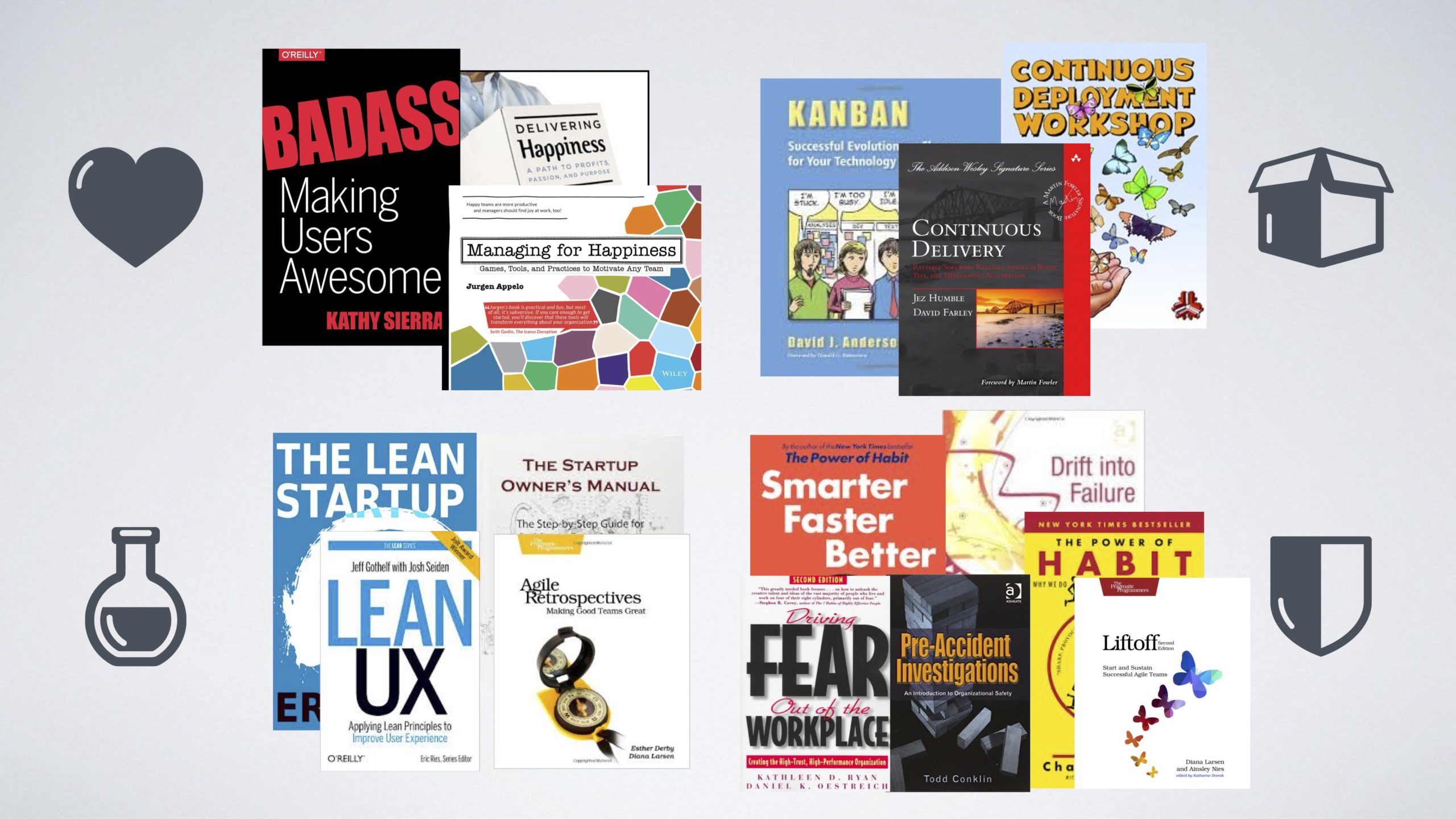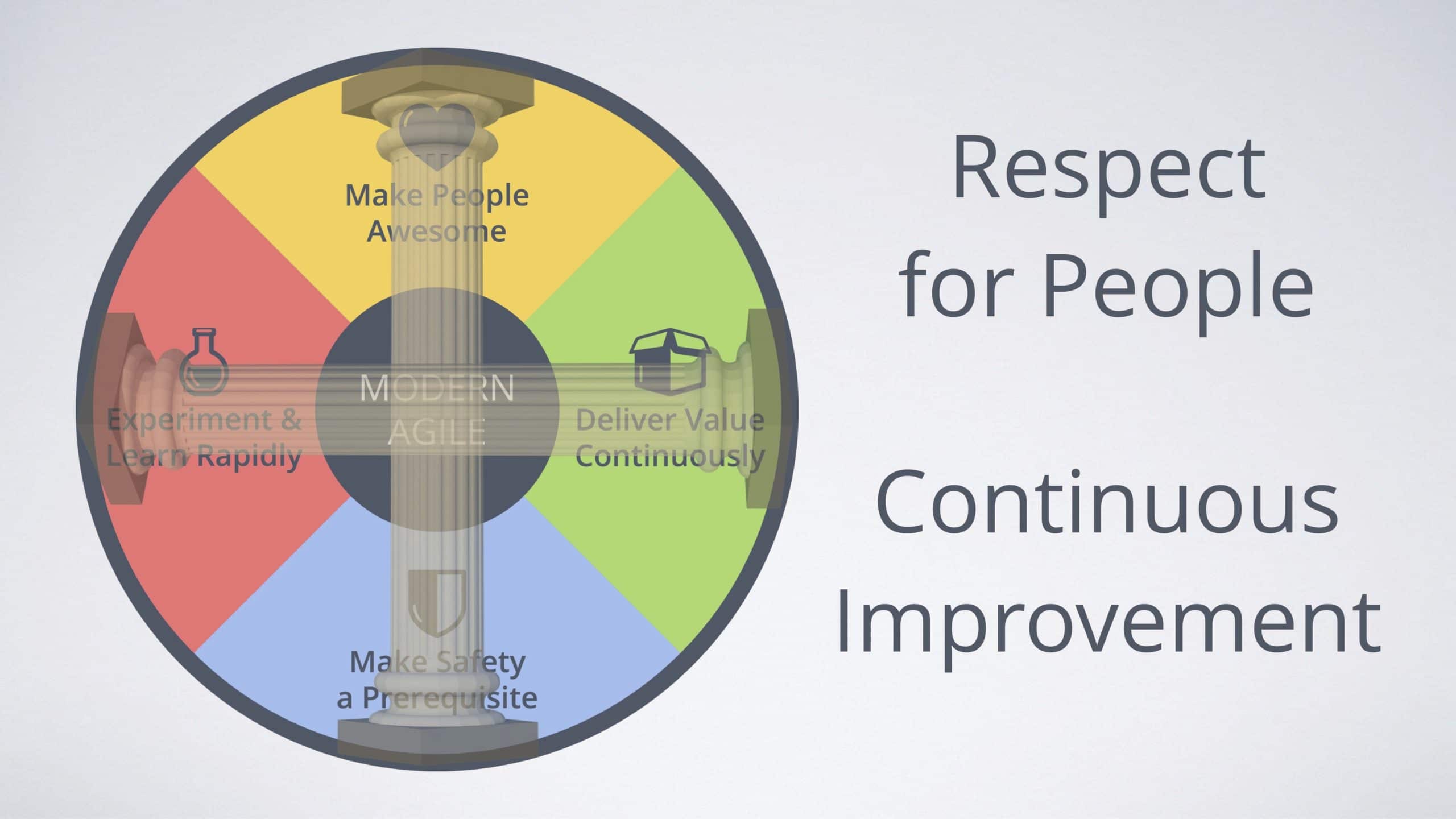
We are already in 2019 this year, and it has now been almost 18 years since the Agile Manifesto was born ! Many people have asked themselves the question in recent years whether this document was still relevant or whether it deserved to be updated: like any concept deserves to adapt to a constantly changing context! Indeed, we see today that Agility no longer stops at the field of software development (assuming it ever was :-P) and therefore that the terminology used is not sufficiently meaningful for everyone.
I had heard of Modern Agile within the community but had not yet taken the time to take an interest in it. Here it is done!
It is a movement driven by Joshua Kerievsky, CEO ofIndustrial Logic, which aims to give a second wind to the Agility that we know traditionally by giving it all the learning acquired over all these years.
I invite you to discover together in this article what Modern Agile is in order to see all that this perspective can bring us! 🙂
Origins

To start our discovery, we might as well go back to the sources. I then became interested in Keynote given by Joshua Kerievsky at the Agile Conference 2016 where he presented the concepts of Modern Agile.
| Note: I really invite you to see it, Joshua is a quality speaker and his conference is just as good! |
A story

Joshua tells us that he once intervened in a company in which he had a work meeting with a manager. In the room was displayed on the wall full of posters with the traditional notions of the type Burndown chart or Cartography of Release.
An exchange then began between them:
Joshua: How is it going for you?
Manager: Very good!
Joshua, sensing something else and looking at all the posters on the wall: And how does this all work for you?
Manager, after a few minutes: Do you want the truth?
Joshua: Yes of course I want the truth!
Manager: Actually, we don't do any of that, these posters were made because we knew you were coming!
Joshua: What are you really doing then?
Manager: Let's say we get together, we choose the work to be done, we roughly estimate what we think we can do and then we do it! Sometimes it works sometimes it doesn't, but that's okay. That's pretty much what we do!
Joshua: That's pretty much what we do too!
| Note: The embarrassment that can be felt in the Manager's speech is similar to what we expressed with Fabien Maury in our conference linking Agility and Anarchism, when during an interview, clients had to talk about their current Agility: “We are (almost) in Scrum”, “Yes we do Agility, finally we try”, “Yes we do hybrid Agile”.
It seems interesting to me to reflect on what leads people to think that what they are doing is good or not: would it be because they implement Agile practices well or because they respond to Agile principles at their way? |
This story is very representative of the vision that companies can have of Agility today: a simple toolbox with practices to implement. Sorry but only setting up the rituals does not make Agile!
Joshua says that in his experience he sometimes saw so-called “Agile” processes even heavier than the previous ones! He compared the feeling he had to seeing people with extremely heavy laptops when today there are extremely thin and light machines! It speaks to you, doesn't it? 😛
In addition, these companies tend to cling to terminology and practices such as " sprints" , THE " burndown charts" , THE " story points" , there " velocity without understanding its intentions.
It is interesting to see that the signatories of the Agile Manifesto themselves can question some of these practices:
Maybe I made up the dots. If so, I'm sorry now.
–Ron Jeffries, in This article
Velocity is killing Agility!
–Jim Highsmith, in This article

So there's nothing inherently wrong with that, it's just that, like technical debt, you have to think about reassessing the impact it may have on our overall operation afterwards.

This is a notion that seems very interesting to me in the sense that when I talk about the values of the Agile Manifesto, I often talk about a cursor to be found between the elements on the left and the elements on the right – cursor which can of course dynamically evolve according to the needs of the moment.
So, as Joshua says, traditional Agile can lack direction and that's probably one of the reasons why a lot of Agile transformation is painful within teams.
The birth of Modern Agile
It has now been almost 18 years since the Agile Manifesto was born and like everything, the question of updating has arisen. It was during an Open Space that Joshua proposed this theme, in order to see what were the really relevant elements to keep up to date, which generated a lot of emulation.

Indeed, many topics have fueled the way we do Agility today: whether around the Management 3.0 of Jurgen Appelo, of Kanban of David J. Anderson, passing through the Lean Startup ofEric Ries or even the Power of Habits of Charles Duhigg. All these subjects are an integral part of the concerns of Agile practitioners and this is difficult to address in the current form of the Agile Manifesto, which is very software development oriented.
Thus, there is not necessarily “new” in Modern Agile, which may raise the question of the term “Modern”. In fact, Joshua shares with us the fact that this term is used to say that despite the fact that many of us know today what works and is useful, it is not known to everyone and it deserves to be shared. Indeed, wisdom can still be applicable today, practices not necessarily!
The future is already here, it's just not evenly distributed
– William Gibson, Author
Modern Agile is therefore intended to be light and has only 4 main guiding principles:

Before going into these principles in more detail, it seemed interesting to me to cite an additional inspiration: the Toyota Production System.
As Joshua points out, we can find 2 pillars of TPS in the figure:
- THE Respect for Individuals : by linking the principles of Make people fantastic and Make security a prerequisite.
- I'Continuous improvement : by linking the principles ofExperiment and learn quickly and Continuously add value.

Alright, let’s go into the details of these principles a bit more! 😉
Make people fantastic

When you read this principle, it may seem a bit utopian… and yet! The original terminology is " Make people awesome which is very Anglo-Saxon but which is very revealing of what we are trying to do: make people brilliant in order to transform the world, to buy with a single click, to make high-quality products, to cooperate towards a common goal...
So the big question is:
How do we make the people in our ecosystem fantastic?
We are therefore talking about our entire ecosystem, which includes the people who buy, make, use, sell or even finance our products or services!
To do this, it is important to get to know:
- their context,
- their sources of suffering,
- which prevents them today from revealing their full potential,
- what they want...
Despite a somewhat pompous-looking title, this principle is extremely powerful when you see the questions that can be answered, for example:
| make fantastic | Sample Question |
| people who buy | Is it simple enough for me to feel able to buy without problems? |
| The people who do | Does our way of working allow us to produce a quality service? |
| people who sell | does my knowledge of users allow me to offer the right offers at the right time? |
| people who use | does this product give me the ability to change the world? |
| people who finance | does this product make me dream enough to be proud to invest in it? |
Continuously add value

When we talk about continuously adding value, we naturally think of the notion of flow, at the heart of the culture of the Toyota Production System.
In the Lean sense, value is defined by the customer. It is therefore necessary to deliver his request as soon as possible so that he can make use of it and become fantastic! 😛
More seriously, this notion of fast delivery to the customer includes different things:
- Prioritize the work to be done : to maximize the value brought to the customer
- Limit work in progress : working on fewer things at the same time to ensure our focus on getting work items out of the system
- Reduce batch size : cut as much as possible in order to allow a greater flow of production of value
- Automate non-value producing tasks : use our intelligence for the tasks that really need it and automate the rest to guarantee a continuous flow
We find here all the notions brought by Kanban and DevOps through the automation of tests, continuous integration and continuous deployment. The important thing is to reduce waiting times as much as possible in order to allow work items to reach the output of the system and therefore its end user quickly.
Make security a prerequisite

When we talk about security, it is mainly psychological security that we are talking about. Indeed, in a study carried out by Google, this element was found to be key for high-performing teams and nonetheless remains a basic human need.
Implementing this principle means ensuring above all else that psychological safety is present before committing to any element of work. The protection of people's time, information, reputation, money, health and relationships is therefore fundamental. This means making its collaborations, products and services resilient and safe.
If you have a culture of fear, none of your fanciful practices or processes will help you.
–Joshua Kerievsky
To start, Joshua shares some tips for safer meetings (adapted from Smarter, faster, better by Charles Duhigg)
- Encourage everyone to contribute
- Listen to each other
- Review/Repeat other people's points
- Avoid domination and interruption
- Being caring, curious and non-judgmental: even when someone says something that annoys you 🙂
We can thus see in this principle all the themes around the soft skills necessary for high-performance teamwork: tools like Non-Violent Communication and the Enneagram (sorry I couldn't help myself :-P ) can be great allies for getting to know each other better, better understanding others and therefore interacting more calmly.
Experiment and learn quickly

It's hard to talk about Agility without talking about experimentation and learning. As I usually say now, the most difficult thing is not in the practices but in the change of paradigm. Indeed, accepting the fact that one does not know and that one needs to do to know is far from simple when one has been trained to find solutions through analysis.
I had the opportunity to experience it during a workshop co-hosted with Caroline Aupert at theAgile Tour Aix Marseille 2018 entitled Strategy and Team Dynamics. Indeed, automatisms easily take over and learning (based on experimentation therefore) is not something natural in our culture.
Going back to Modern Agile, it's interesting to see how each principle feeds off the others and vice versa:
- Experimenting and Learning is a way to make people great, to provide continuous value and to build a safe environment for people.
- It is equally important:
- to have fantastic people to implement the experiments and bring out the appropriate learnings
- to have the ability to bring the experiment to the end in order to be able to draw the hoped-for learnings from it
- to build “Safe to Fail” experiments in order to encourage initiative and fuel this virtuous circle
We can think here of tools for structuring experimentation such as the Lean A3, there Strategizer Test Card or PopcornFlow to follow this learning flow.
Modern Agile in action

Joshua tells the story of Taka, a sous chef at a 3-star Michelin restaurant in Northern Italy. While he still had to serve 2 lemon pies to his guests, Taka unfortunately dropped one of his pies. It fell on the side of the plate on the counter, and shattered. Taka was obviously very annoyed.
His chef Osteria Francescana Massimo Bottura told him:
“Taka, wait, wait. (Making a frame with his fingers) Look through my fingers, it's beautiful. Let's do it again as if it were a broken element. »
By reproducing the same design on the other pie with great precision, the idea was to make the guests think that it was done on purpose. This was the moment when was created " Oops. I dropped my lemon pie. »
In this story, we can see the 4 principles of Modern Agile at work:
| Modern Agile Principle | In practice |
| Make people fantastic | Chef Bottura knew how to make his sous-chef proud for having participated in the creation of something new, he knew how to delight the guests with an original-looking dish. |
| Continuously add value | Chef Bottura was able to assess the situation with curiosity and focus his attention on what could bring value to the customer while not wasting the work and the effort provided. |
| Make security a prerequisite | Taka didn't feel endangered or blamed in any way, he managed to trust himself to be able to implement the second plate. |
| Experiment and learn quickly | Having the courage to set up the second plate and assume to take it to the guests is indeed an experiment allowing them to see if it could please! This learning allowed them to transform what could have appeared as a blunder into a pleasant anecdote to tell! |
| Note: Here is the video of the story told by Chef Bottura, if you are curious 🙂 |
What about the Agile Manifesto then?

Joshua is not talking about abolishing the Agile Manifesto but rather humbly updating it.
Indeed, the first sentence of the Agile Manifesto consists of saying:
We discover how to develop software better by doing and helping others to do it
could be replaced with a more results-focused phrase like:
We discover how best to achieve fantastic results
Following his article posted on the Industrial Logic blog, correspondences between the principles of Modern Agile and the values of the Agile Manifesto emerged thanks to the help of Karl Scotland:
| Agile Manifesto | Modern Agile |
| Customer cooperation | Make people fantastic |
| Operational software | Continuously add value |
| Adapting to change | Experiment and learn quickly |
| Individuals and interactions | Make security a prerequisite |
It is therefore a rewriting that is proposed here: more engaging, more open and more adapted to the contexts that we encounter today. In other words, more modern! 😉
Note that we also remove the formulation by comparison present in the Agile Manifesto and which may have generated many implementation drifts.
Conclusion

Modern Agile therefore aims to breathe new life into the traditional Agility we know by adapting it to current practices and nourishing it with all the learning accumulated over the past decade.
It's another way of talking about Agility, staying in line with the initial ideas, but allowing a more open discourse to other disciplines outside of software development. Now, even though I find the discourse more impactful on a values level, I think the principles underlying the Agile Manifesto remain useful for exploration, perhaps they also deserve to be rewritten in order to have a more great impact.
Personally, I find this approach to be very relevant and consistent with others such as Heart of Agile or even theAgile-Rocket that are intended to be flexible, adaptive and based on guiding intentions.
I hope this article has made you want to dive into it and use it at home, at least that will be the case for me! 😉
References
- http://modernagile.org/
- https://blog.intech.lu/index.php/2017/01/03/la-vague-modern-agile/
- https://www.agilealliance.org/resources/videos/modern-agile/
- https://medium.com/agile-insights/modern-agile-what-is-it-and-why-is-it-a-great-thing-66ae7821a722
- https://blog.crisp.se/2018/06/27/mikaelbrodd/modern-agile
- https://eric.siber.fr/2016/09/08/modern-agile-declinaison-francophone-principes/
- https://www.infoq.com/articles/modern-agile-intro
- https://www.industriallogic.com/blog/modern-agile/
- http://www.les-traducteurs-agiles.org/2018/09/19/modern-agile.html
- https://fr.slideshare.net/AgileSparks/modern-agile-joshua-kerievsk







4 Responses
Thank you for the summary and for the very useful links!
Thank you for this presentation.
Thanks for the explanation Oliver!
The visual representation at the beginning of the article reminded me of "Heart Of Agile", and your explanation of the principles the more holistic view of Agile Rocket 🙂
The mapping, in any case the links between these different models, would be interesting to do!
Hello and thank you for this detailed article.
It might be interesting to see other modern approaches to agility together.